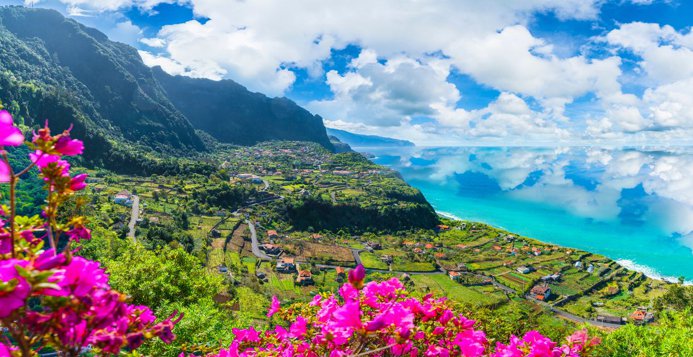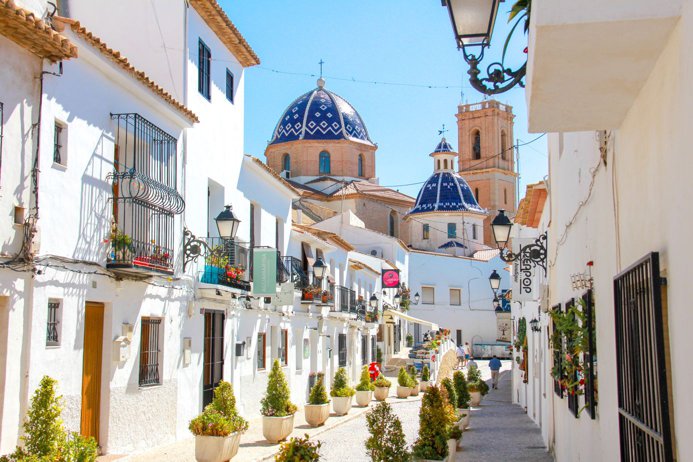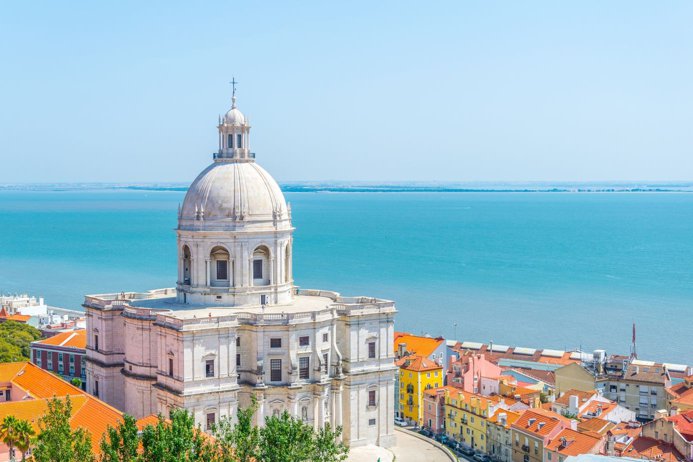Spain vs. Portugal: the definitive guide for overseas property investors

Spain is one of the world’s most popular destinations to visit, and many tourists return to buy property here. Portugal has yet to gain the same level of popularity – 27 million tourists visited in Portugal in 2019 compared to 83.7 million for Spain. Portugal is often overshadowed by Spain, but the conditions for living and property acquisition are worth considering too.
| Spain | Wide range of bargain properties Higher quality of healthcare More regional diversity |
Budget-friendly housing prices Residence permit by property investment Favourable mortgage terms Mature leisure infrastructure Warm and sunny climate, clean environment High safety level Healthy Mediterranean cuisine Welcoming to foreigners |
|---|---|---|
| Portugal | Milder climate Lower taxes Cheaper property maintenance Lower property acquisition charges Lower cost of living |
Real estate prices
Spain. The average real estate price in Spain is €1,500/m². Apartments in Spain are priced from €60,000 to €70,000. House prices start at €200,000 and upwards, especially in large cities and popular resorts. The most expensive properties on the market are in the autonomous community of Catalonia. The average house price in Barcelona, the capital of Catalonia, and the resorts in Costa del Garraf is €3,500/m². The scenic and verdant Costa Brava in Northern Catalonia has a range of budget options offering apartments for €100,000−120,000, residences in private complexes and standalone houses in Lloret de Mar for €200,000, chalets for €700,000, and villas for several millions of euro.
The north of Spain also has popular and picturesque regions, such as the Basque Country and Asturias. The Basque Country is the most expensive region in Spain with prices per square metre averaging €2,600/m², compared to house prices in Asturias of €1,400/m².
Pre-owned homes in Alicante resorts cost €60,000−70,000 and upwards, and off-plan property prices start from €100,000. Generally, Spain has a wide selection of real estate to fit any budget because there are many new developments.
There are bargain new-build homes on the Spanish market, for example in Costa Blanca. A hefty supply of off-plan properties here is driven by extensive new development along the coast and vibrant competition among developers.
Spain is one of the best countries for a foreigner to obtain an affordable mortgage.

Portugal. Lisbon, the Lisbon coastal area or Lisbon Riviera, and the Algarve are the most popular regions to buy property in Portugal. Many foreigners are looking to buy property in the island of Madeira, lured by picture-perfect panoramas and its mild climate (average temperatures range from 16–25°C year-round).
Portugal is one of the least expensive countries to live in, though real estate prices are not very low. House prices vary from €180,000 to €600,000, apartments sell for €70,000–350,000 and might even cost millions in the Golden Triangle resorts of Portugal, such as Vilamoura, Vale do Lobo, and Quinta Do Lago.
Apartments in Lisbon are priced at about €4,000/m² in renovated buildings. Apartment prices along the Lisbon Riviera vary from €200,000 to several millions of euro. Real estate prices average €2,500/m2 in the most popular resorts of the Algarve: Albufeira, Portimão, Faro, and Lagos. Property prices in Madeira start from €1,600/m2.

Purchase and registration of property
The extra costs incurred to purchase residential property in Spain are higher than the overheads in Portugal. It costs an extra 12–15% of the price to register the property in Spain, whereas the respective costs in Portugal average about 10–15% of the purchase price depending on the region, property type, and mortgage.
As of September 2016, the average housing price across Spain was €1,636 per sq m., according to Spanish real estate service Fotocasa. However, prices vary tremendously by property type and region. For example, one can find a modest 3-bedroom apartment just outside of the popular port city of Valencia for as little as €18,500, or a sumptuous 12-bedroom villa in Marbella for €85,000,000.
Spain | Portugal | |
|---|---|---|
Legal fees | €1,000−2,000 | 1−1.5% transaction value |
Notary fees | €600−1,000 | €500−700 |
TIN registration | €9.5 | €7.5 |
Title registration fee | €300−650 | €250−600 |
Real estate transfer tax (on pre-owned properties) | 6−10% | 1−6.5% |
Stamp duty (on off-plan developments) | 0.5-1.5% | 0.8% + 0.6%, if mortgage is raised |
VAT (on off-plan developments) | 10% | none |
Mortgage loans
The overall mortgage terms for non-residents are similar across the Iberian Peninsula. However, unlike Spain that is geared toward simplicity for foreign borrowers, Portugal offers expat applicants a more convoluted path to financing. Portuguese banks impose stricter requirements on a borrower opening an account. Mortgage applicants in both Portugal and Spain are obliged to have the purchased property insured.
Spain | Portugal | |
|---|---|---|
Downpayment | 30% | 30−50% |
Rate | 3−3.5% | 1.7−3.3% |
Monthly payments | No more than 35% income of the borrower | No more than 35% income of the borrower |
Minimum loan amount | €50,000 | €60,000 |
Maximum loan amount | Up to 70% property value | Up to 70% property value |
Term to maturity (in years) | Up to 25 years | Up to 40 years |
Age limit (in years) | 65 | 75 |
Property maintenance
Property maintenance expenses include costs incurred to pay taxes, insurance charges, management company fees, and utilities. Average property maintenance costs are €2,000 per year in Portugal and €2,000–2,500 per year in Spain.
Spain | Portugal | |
|---|---|---|
Utility charges | €80−120 per month | €70−100 per month |
Residential complex service charge | €40−100 per month | €40−200 per month |
Insurance fee (for a mortgage) | €200−400 per month | €200−400 per month |
Annual property tax | 0.4−1.1% cadastral value of property | 0.3−0.8% cadastral value of property |
Taxes
The total tax burden in Portugal is lower than in Spain. Portugal does not impose some taxes that are charged in Spain, but some levies present in both countries are higher here. To illustrate, Portugal does not charge capital gains tax on urban land. Inheritance tax, as well as some other charges, is also considerably lower. Whether you choose Portugal or Spain, the overall tax burden for a buyer is variable and depends on a number of factors (e.g., municipality, property type, etc.).
Spain | Portugal | |
|---|---|---|
VAT | 10−21% | 23% |
Income tax rate for non-residents | 24% | 25% |
Wealth tax | 0.2−2.5% for properties valued over €700,000 | 0.4−1% for properties valued over €600,000 |
Inheritance tax | 7.65−34% | none (for close relatives) or 10% |
Rental income tax (on rental property) | 24% (19% for EU residents) | 28% |
Capital gains tax (on sale of property) | 19% | 28% |
Capital gains tax on urban land (to be paid by the property seller) | Rates vary by municipality | none |
Immigration law
Both countries are members of the Schengen Zone, so their visa rules for non-residents are the same. The rules to obtain a residence permit or citizenship are also similar. The Golden Visa Programme that grants non-residents a residence permit for property investment is in place in both Spain and Portugal, though rules slightly vary by country:
Permanent residence may be obtained in Portugal five years after a golden visa is granted, and citizenship may be applied for the year after that. Permanent residence is granted after five years of living in Spain, and citizenship in Spain can be applied for after at least 10 years of life in the country.
The Portuguese golden visa is available for both the applicant and their family. It allows visa-free travel within all EU countries and unlimited stay in Portugal.
However, the Golden Visa Programme will close in major cities, such as Lisbon and Porto, and some coastal areas of Portugal at the end of 2020, so applicants looking to invest here should hurry up.
Climate and environment
Spain and Portugal are some of the warmest countries in Europe, enjoying around 2,500–3,000 hours of sunshine per year, compared to London, which gets just 1,573 hours of sun per year and 164 days of rain.
Spain’s geography favours a more diverse climate. Asturias, a province in the north of Spain, and the Basque Country have lush vegetation and a milder climate than the southern regions of Valencia, Andalucia, and Murcia. The climate in the centre of the country is continental, with cold winters and very hot summers.
The Atlantic Ocean governs the climate in the coastal areas of Portugal. Summers are not very hot thanks to the ocean wind, and winters are mild and humid. Summer on the Lisbon Riviera and Algarve last almost six months from May to October. Lisbon is considered one of Europe's warmest capitals: even in winter, temperatures never fall below +5°С.

In 2020, the Environmental Performance Index ranked Spain as the 14th cleanest country in the world, followed by Portugal in 27th position.
Leisure infrastructure
Spain was the most tourist-friendly country in the world from 2015 to 2019, according to a ranking by the World Economic Forum. There are plenty of leisure opportunities here: museums and architectural landmarks in Madrid, Valencia, Granada, and Barcelona, 15 national parks, numerous resorts along the Mediterranean and Atlantic coasts, superb cuisine, vibrant nightlife, colourful carnivals, and traditional festivals.

Spain is the European leader by the blue-flag beaches and it is the second country in the world by number of UNESCO World Heritage Sites.
Portugal is not so widely promoted as Spain, but has every opportunity for rest and relaxation: clean beaches, perfect waves for surfing, walking and cycling paths along the ocean coast and in the mountains, history museums, ancient palaces and castles, Michelin-star restaurants, nightclubs, and spa resorts.
Foreign visitors come to Portugal to admire the incredible nature of the Azores Islands and Madeira or to wonder at the ancient architecture of Coimbra, Lisbon, and Sintra. When it comes to resort infrastructure, Portugal ranks 5th in Europe by number of blue-flag beaches.

Portugal is one of the world's best regions for golf lovers, not to mention a popular destination in Europe for novice and professional surfers.
Food
Foreigners coming to Spain or Portugal love the high quality of local produce grown without chemicals. For example, both Portugal and Spain prohibit the use of glyphosate, a herbicide widely used in agriculture elsewhere. Organic produce is very popular in both countries.
Local cuisine based on a blend of fresh seafood, fruit, and vegetables plays a big part in the longevity and health of locals. Many scientists note that the Mediterranean diet has a very positive impact on the health of both nations. Spanish and Portuguese wines regularly win international awards for quality and flavour.

Cost of living
Many residents of the UK, Germany, the USA, France, and Northern European countries retire and move to Portugal. Portugal is a popular country among retirees for the low cost of living and balmy climate. The average monthly living costs in Portugal are €1,400 for a single person. A retired couple with a combined income of €25,000 a year moving to Lisbon from the USA can afford the best beauty salons and nights out with friends at least several times a week.
Portugal has the lowest cost of living in Western Europe. Expats with earnings on par with other Europeans find that food, utilities, medicine, and education are cheaper here.
For example, it would cost two people €20–30 to eat out at a restaurant in Portugal, whereas a restaurant meal for two in Spain would be at least €40.
Living costs in Spain are higher than in Portugal. A single person would spend on average €1,600 per month on living, and the average monthly living expenditure of a family with a child would be €2,500–€3,000. According to the web portal Numbeo, consumer goods in Portugal are 12% cheaper than in Spain on average, and restaurant prices are 32% lower.
Meanwhile, Spain is cheaper than many European countries. Consumer prices in Spain are 21% lower than in Germany and the UK, and a restaurant meal in Barcelona would cost 38% less than in London.
Spain | Portugal | |
|---|---|---|
A restaurant meal for two | €40 | €30 |
A bottle of water | €1.1 | €0.9 |
Taxi fare (for one km) | €1.1 | €0.5 |
Monthly internet fee | €40 | €33 |
Movie ticket | €8 | €7 |
Monthly gym membership | €37 | €33 |
Healthcare
Spain is the healthiest nation in the world according to the 2019 ranking by Bloomberg drawing on the data reported by the WHO. Portugal holds the 22nd position, compared to the USA (35th).
According to the OECD, life expectancy is 81 years in Portugal and 83 years in Spain. These fairly high lifespan values are supported by the established healthcare systems in both countries.
The web portal Numbeo ranked Spain’s healthcare system 6th worldwide in 2020. Portugal came in 23rd position, well ahead of many European countries, including Ireland, Cyprus, Malta and Italy.

Spain is also one of the world’s top destinations for health and spa tourism. There are over 2,000 thermal and mineral springs here used for mineral water treatments in balneological centres. Portugal also draws tourists from all over Europe who come here for leisure and treatments attracted by lower prices and high-quality medical services.
Attitude towards foreigners
Spaniards and the Portuguese are regularly elected the most hospitable nations on the planet. The World Economic Forum ranked Spain and Portugal 2nd and 4th respectively in its list of the world’s friendliest countries for tourists.
According to the global expat community InterNations, Portugal and Spain are the most welcoming countries in the world. Portugal came in 3rd position, and Spain occupies the 11th place in their friendliness ranking.
Safety
The 2019 Global Peace Index ranked Portugal among the world’s top three most peaceful nations, only outdone by Iceland and New Zealand. Spain came in 32nd, which is an excellent result too, beating France, the Baltic nations, the UK, Italy and Cyprus.
We will send you a content digest not more than once a week
















